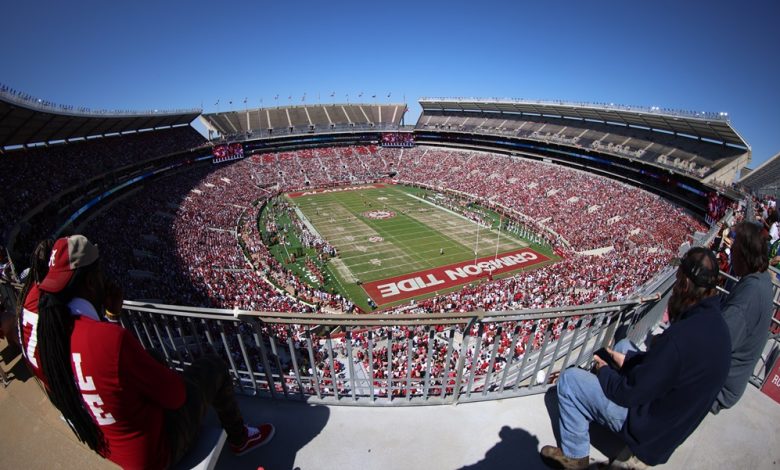Tuscaloosa doesn’t want Alabama football’s A-Day anymore. Mayor Walt Maddox would rather the spring game go away due to security and logistical concerns.

In the heart of Alabama, where college football is not just a sport but a way of life, a surprising sentiment is emerging from one of the state’s most prominent voices. Tuscaloosa Mayor Walt Maddox, a longtime leader in the city that proudly hosts the University of Alabama and its storied football program, has made waves with a bold declaration: it may be time for A-Day, Alabama football’s annual spring game, to come to an end.
For many Crimson Tide fans, A-Day is a cherished tradition. It’s a springtime celebration — a free, open-to-the-public scrimmage that provides a preview of the upcoming season. Held inside Bryant-Denny Stadium, it’s part football, part festival, and part recruiting showcase. But behind the scenes, city leaders like Maddox are facing mounting challenges that have made the event more burdensome than beneficial.
In a recent interview, Maddox did not mince words.
“We love the University of Alabama, and we support the football program,” he began. “But A-Day, as it currently exists, has become a logistical and security headache that far outweighs its benefits. It’s time to ask some serious questions about whether this event is worth the disruption it causes every year.”
Maddox cited several concerns that have grown in recent years — from overcrowding and increased public safety risks to the cost of city services that aren’t reimbursed. He emphasized that while the game brings fans to town, it doesn’t generate the kind of economic return one might expect.
“We don’t charge for the game. There’s no ticket revenue, and yet the city still has to cover the costs of traffic control, emergency services, sanitation, and security. All of that comes from taxpayers — and for what? There’s no financial return to the city like there is during a regular football weekend.
Among Maddox’s top concerns is public safety. He pointed to a growing trend of large-scale tailgating and crowds that spill out beyond the stadium into surrounding neighborhoods, streets, and public spaces — all without the benefit of the university’s usual gameday infrastructure.
“What makes A-Day different from a typical fall Saturday is that we’re not fully staffed like we would be during the season,” Maddox said. “Yet the crowd sizes are creeping closer and closer to those fall game levels, especially when there’s a new coach, a new quarterback, or a Heisman contender. It stretches our police, our fire department, our EMTs — it puts everyone under strain.”
The rise of social media-driven fan events and influencer promotions around A-Day has only amplified the issue. What once was a relatively low-key affair has turned into a high-traffic, high-profile gathering, complete with pop-up parties, tailgate competitions, and influencer meet-ups — none of which are coordinated with the city or the university.
Maddox noted that while football weekends during the fall bring enormous economic benefits — with fans staying in hotels, eating at restaurants, and shopping locally — A-Day doesn’t have the same effect. Because the game is free and typically held during the day, many visitors don’t spend the night or make major purchases.
“People drive in from Birmingham or Montgomery, park for free, watch the game, tailgate a little, and then leave. That’s great from a fan perspective, but from a municipal services perspective, it’s a net loss,” Maddox explained. “We’re paying overtime to police officers, firefighters, and sanitation workers for a crowd that doesn’t generate hotel tax, sales tax, or even pay admission to the event itself.”
In short, the city absorbs the cost — often hundreds of thousands of dollars — without the economic bump to offset it
The situation reached a tipping point during the 2025 A-Day, held in April. It was the first spring game under new Alabama head coach Kalen DeBoer, and anticipation was sky-high. Fans wanted to see how DeBoer would carry on the dynasty built by Nick Saban, who retired at the end of the 2024 season.
Bryant-Denny Stadium was packed. Attendance was announced at over 63,000 — one of the largest spring game crowds in the country. But it wasn’t just inside the stadium where crowds gathered. Surrounding blocks were jammed with cars, pedestrians, and tailgaters, creating a scenario Tuscaloosa’s public safety officials were not fully prepared to handle.
There were multiple arrests for disorderly conduct, a few minor medical emergencies, and at least one instance where an ambulance was delayed in reaching a patient due to gridlock around University Boulevard. While there was no major crisis, city officials say it was a close call.
“It was a perfect storm,” said Tuscaloosa Police Chief Brent Blankley. “We were undermanned. The roads were clogged. Emergency response times were longer than acceptable. If something major had happened, we would’ve struggled to respond in time.
Despite his criticisms, Maddox made it clear that the issue isn’t with the University of Alabama or its football program directly. He praised the institution for its cooperation and partnership with the city on numerous issues over the years.
“This isn’t an anti-UA stance,” Maddox clarified. “It’s about how we adapt to changing circumstances. We’re not the same Tuscaloosa we were in 2005. We’re a growing city with new infrastructure, new development, and new challenges. We have to be smart about how we use our resources.”
He also acknowledged that the university has made efforts to improve coordination, but argued that A-Day is no longer a manageable event under its current model.
“We need to reevaluate — maybe move the event indoors to Coleman Coliseum, or scale it down entirely,” Maddox suggested. “Maybe it’s time for A-Day to be a closed scrimmage with a media window and televised highlights. That would still serve the purpose without overburdening the city.”
The reaction to Maddox’s comments has been mixed. Some residents and business owners agree that A-Day has become more trouble than it’s worth, particularly those who live near the stadium and deal with traffic, noise, and litter. Others — especially long-time fans — see the mayor’s comments as sacrilegious.
“To say Tuscaloosa doesn’t want A-Day is like saying Memphis doesn’t want Beale Street,” one Crimson Tide fan posted on X (formerly Twitter). “It’s part of who we are.”
But Maddox insists his stance isn’t about nostalgia or loyalty — it’s about sustainability and responsibility.
“There’s a difference between tradition and obligation,” Maddox said. “We can respect our traditions while still asking whether they make sense in today’s world. A-Day has outgrown its original purpose, and now it’s time to rethink what it should be moving forward.”
The University of Alabama has not yet publicly responded to Maddox’s remarks, though sources within the athletic department suggest the school is aware of the mayor’s concerns and is willing to open discussions about possible changes to the event.
In the meantime, city officials are conducting a full review of the 2025 A-Day, including detailed assessments of public safety responses, traffic flow, sanitation costs, and emergency services. The findings from that report could determine whether Maddox’s suggestion becomes official policy or simply a point of debate.
One potential compromise being floated involves limiting the event to a smaller, ticketed audience and capping attendance — similar to how other Power Five schools manage their spring games. Another option could be holding the game earlier in the day with restrictions on tailgating or closing certain roads to reduce congestion.
Ultimately, the future of A-Day hangs in the balance. For fans, it may feel unthinkable to imagine a spring without the scrimmage. But for city officials charged with keeping Tuscaloosa safe and running smoothly, the tradition may no longer justify the toll it takes.
As Maddox put it: “We’re proud to be the home of Alabama football. But pride doesn’t pay for overtime, it doesn’t unclog traffic, and it doesn’t protect public safety. We need to be honest about what works — and what doesn’t.”









